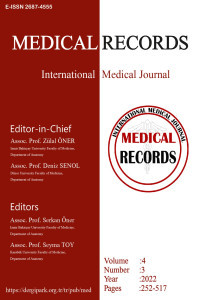MATERNAL BISPHENOL-A'NIN SIÇAN BÖBREK GELİŞİMİ ÜZERİNDEKİ ETKİSİNİN İNCELENMESİ
Bisfenol-A, üre, kreatinin, oksifatif stress
Examining the Impact of Maternally Administered Bisphenol-A on Rat Kidney Development
Bisphenol-A (BPA), urea, creatinine, oxidative stress,
___
- 1. Esplugas R, Llovet MI, Bellés M, et al. Renal and hepatic effects following neonatal exposure to low doses of Bisphenol-A and 137Cs. Food Chem Toxicol. 2018;114:270-7.
- 2. Çelik Y, Şahin S. Health effects of bisphenol a as an endocrine disrupting chemical. Sürekli Tıp Eğitimi Dergisi 2020;29:439-45.
- 3. Wang M, Rang O, Liu F, et al. A systematic review of metabolomics biomarkers for Bisphenol A exposure. Metabolomics. 2018;14:45.
- 4. Nakamura K, Itoh K, Sugimoto T, Fushiki S. Prenatal exposure to bisphenol A affects adult murine neocortical structure. Neurosci Lett. 2007;420:100-5.
- 5. Rezg R, El-Fazaa S, Gharbi N, Mornagui B. Bisphenol A and human chronic diseases: current evidences, possible mechanisms, and future perspectives. Environ Int. 2014;64:83-90.
- 6. Ola-Davies OE, Olukole SG. Gallic acid protects against bisphenol A-induced alterations in the cardio-renal system of Wistar rats through the antioxidant defense mechanism. Biomed Pharmacother. 2018;107:1786-94.
- 7. Poormoosavi SM, Najafzadehvarzi H, Behmanesh MA, Amirgholami R. Protective effects of Asparagus officinalis extract against Bisphenol A- induced toxicity in Wistar rats. Toxicol Rep. 2018;5:427-33.
- 8. Yaprak M, Bay F, Turgut FH. Endocrine disruptors and kidney. Turkiye Klinikleri J Endocrin-Special Topics. 2017;9:45-9.
- 9. Yuan J, Kong Y, Ommati MM, et al. Bisphenol A-induced apoptosis, oxidative stress and DNA damage in cultured rhesus monkey embryo renal epithelial Marc-145 cells. Chemosphere. 2019;234:682-9.
- 10. Ayazgök B, Küçükkilinç TT. big effects of low dose Bisphenol A. FABAD J Pharm Sci. 2017;42:139-50.
- 11. Kovacic P. How safe is bisphenol A? Fundamentals of toxicity: metabolism, electron transfer and oxidative stress. Med Hypotheses. 2010;75:1-4.
- 12. Kobroob A, Peerapanyasut W, Chattipakorn N, Wongmekiat O. Damaging effects of bisphenol A on the kidney and the protection by melatonin: emerging evidences from in vivo and in vitro studies. Oxid Med Cell Longev. 2018;2018:3082438.
- 13. Aydos Z, Boyacioğlu M. The Investigaton of the protective effect of folic acid on experimental Bisphenol A toxication in rats. Animal Health Production and Hygiene. 2019;8:642-6.
- 14. Edres HA, Taha NM, Mandour A, Lebda M. Impact of L-Carnitine on Bisphenol A-induced kidney damage in rats. Alexandria Journal of Veterinary Sciences. 2018;56:11-7.
- 15. Shin BS, Yoo SD, Cho CY, et al. Maternal-fetal disposition of bisphenol a in pregnant Sprague-Dawley rats. J Toxicol Environ Health A. 2002;65:395-406.
- 16. Kabuto H, Amakawa M, Shishibori T. Exposure to bisphenol A during embryonic/fetal life and infancy increases oxidative injury and causes underdevelopment of the brain and testis in mice. Life Sci. 2004;74:2931-40.
- Yayın Aralığı: Yılda 3 Sayı
- Başlangıç: 2019
- Yayıncı: Zülal ÖNER
Retrospective Analysis of Our Experience with Percutaneous Tracheostomy in Our Intensive Care Unit
Kenan KART, Alpay ATEŞ, Müge ARIKAN
Evaluation of Poisoning Cases Presenting to the Pediatric Emergency Department
İlknur KABA, Samet Can DEMİRBAŞ, Havva Nur Peltek KENDİRCİ
Tuba OZCAN METİN, Gulsen BAYRAK, Selma YAMAN, Adem DOĞANER, Atila YOLDAŞ, Nadire ESER, Duygun ALTINTAŞ AYKAN, Banu YILMAZ, Akif Hakan KURT, Mehmet ŞAHİN, Gulsah GURBUZ
MATERNAL BISPHENOL-A'NIN SIÇAN BÖBREK GELİŞİMİ ÜZERİNDEKİ ETKİSİNİN İNCELENMESİ
Dilek MEYDAN, Semih TAN, Saim ÖZDAMAR, Hülya ÇETİN
Mahmut Zabit KARA, Mehmet Hamdi ÖRÜM, Ayşe Sevgi KARADAĞ, Aysun KALENDEROĞLU
Can Cranium Size be Predicted from Orbit Dimensions?
Hasan Esat YÜCEL, Tufan ULCAY, Ozkan GORGULU, Kağan TUR, Muhammed Hüseyin KIRINDI, Elif ÇÖMLEKÇİ, Emre UĞUZ, Berat YAĞMUR, Burcu KAMAŞAK, Ahmet UZUN
Did the COVID-19 Pandemic Period Increased Suicide Attempts in Society?
Lomber Disk Hernili Hastalarda Q açısı ve Hamstring Uzunluğunun Denge Performansına Etkisi
